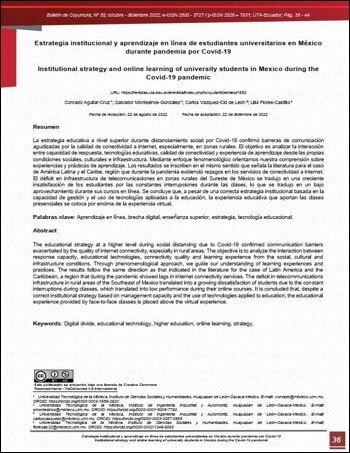Institutional strategy and online learning of university students in Mexico during the Covid-19 pandemic
Main Article Content
Abstract
The educational strategy at a higher level during social distancing due to Covid-19 confirmed communication barriers exacerbated by the quality of internet connectivity, especially in rural areas. The objective is to analyze the interaction between response capacity, educational technologies, connectivity quality and learning experience from the social, cultural and infrastructure conditions. Through phenomenological approach, we guide our understanding of learning experiences and practices. The results follow the same direction as that indicated in the literature for the case of Latin America and the Caribbean, a region that during the pandemic showed lags in internet connectivity services. The deficit in telecommunications infrastructure in rural areas of the Southeast of Mexico translated into a growing dissatisfaction of students due to the constant interruptions during classes, which translated into low performance during their online courses. It is concluded that, despite a correct institutional strategy based on management capacity and the use of technologies applied to education, the educational experience provided by face-to-face classes is placed above the virtual experience.
URL: https://revistas.uta.edu.ec/erevista/index.php/bcoyu/article/view/1852
Downloads
Article Details

This work is licensed under a Creative Commons Attribution-NonCommercial 4.0 International License.
![]()
The publications of the Boletín de Coyuntura are licensed under a Creative Commons Attribution-NonCommercial 4.0 International License (CC BY-NC 4.0). The Universidad Técnica de Ambato retains the copyright of the published works, and favors and allows the reuse of these, as long as: the authorship and original source of publication is cited, and they are not used for commercial or onerous purposes. The intellectual property of the published articles belongs to the authors.
References
Amit, R., & Schoemaker, P.J.H. (1993). Strategic assets and organizational rent. Strategic Management Journal, 14(1), 33-46. https://doi.org/10.1002/smj.4250140105
Babbar, M., & Gupta, T. (2022). Response of educational institutions to COVID-19 pandemic: An inter-country comparison. Policy Futures in Education, 20(4), 469–491. https://doi.org/10.1177/14782103211021937
Banco Mundial (2016). Informe sobre el desarrollo mundial: brechas digitales. bit.ly/3OUGGlg
Bianchi, C., Glavas, Ch., & Mathews, S. (2017). SME international performance in Latin America: The role of entrepreneurial and technological capabilities. Journal of small business and enterprise development, 24(1), 176-195. https://doi.org/10.1108/JSBED-09-2016-0142
Braun, V., & Clarke, V. (2006). Using thematic analysis in psychology. Qualitative Research in Psychology, 3(2), 77-101. https://doi.org/10.1191/1478088706qp063oa
Creswell, J.W., & Poth, Ch. N. (2018). Qualitative inquiry research design. Choosing among five approaches (4ª. Ed.). Sage Publications.
Delgado, A.J., Wardlow, L., McKnight, K., & O´Malley, K. (2015). Educational technology: A review of the integration, resources, and effectiveness of technology in K-12 classrooms. Journal of information technology education: Research. (14), 397-416. https://bit.ly/3LGist1
Egea, O.M. (2014). Neoliberalism, education and the integration of ICT in schools. A critical reading. Technology, Pedagogy and Education, 23(2), 267-283. https://doi.org/10.1080/1475939X.2013.810168
Engen, B. (2019). Understanding social and cultural aspects of teachers digital Competencies [Comprendiendo los aspectos culturales y sociales de las competencias digitales docentes]. Comunicar. Revista científica de educación, (61), 9-19. https://bit.ly/3MJRu3P
Folegotto I. E. & Tambornino, R. (2005). Las tic y los nuevos paradigmas para la educación. Congreso en Tecnologías de la Información y Comunicación en la Enseñanza de las Ciencias. Red de Universidades con Carreras en Informática, 299-309. https://bit.ly/3KwPuL3
Galperín, H. (2017). Sociedad digital: brechas y retos para la inclusión digital en América Latina y el Caribe. UNESCO. https://bit.ly/3w89kXH
Gobierno del estado de Oaxaca (1990). Extra periódico oficial. Órgano del gobierno constitucional del estado libre y soberano de Oaxaca. Decreto número 6, por el cual se crea el organismo público descentralizado de carácter estatal denominado Universidad Tecnológica de la Mixteca. https://bit.ly/377KvCK
Guevara, G. (2010). Aprendizaje basado en problemas como técnica didáctica para la enseñanza del tema de la recursividad. InterSedes, (20),154-182. https://bit.ly/3MG8b00
Gutiérrez, J.M., Mora, C. E., Añorbe, B., & González, A. (2017). Virtual Technologies Trends in Education. EURASIA. Journal of Mathematics Science and Technology Education. https://doi.org/10.12973/eurasia.2017.00626a
Hameed, A., Mian, A. N., & Qadir, J. (2018). Low-cost sustainable Wireless internet service for rural áreas. Wireless Netw, 24, 1439-1450. https://doi.org/10.1007/s11276-016-1415-8
Hobbs, L., & Butterworth (1999). Designing internet home pages made simple. España: Marcombo.INEGI (2019). Encuesta Nacional sobre Disponibilidad y Uso de Tecnologías de la Información en los Hogares (ENDUTIH). https://bit.ly/39lyY3p
Huang, F; Teo, T; & Scherer, R. (2020). Investigating the antecedents of university students’ perceived ease of using the Internet for learning. Interactive Learning Environments, 6(30). https://doi.org/10.1080/10494820.2019.1710540
Krammer, F. (2020). SARS-CoV-2 vaccines in development. Nature, 586 ,516-517. Krammer, F. Vacunas contra el SARS-CoV-2 en desarrollo. Nature, 586, 516–527 (2020). https://doi.org/10.1038/s41586-020-2798-3
Kumar, A; & Srinivasan, R. (2020). Impact of Pandemic COVID-19 on the Teaching – Learning Process: A Study of Higher Education Teachers, 4(13). https:/doi.org/10.17010/pijom/2020/v13i4/151825
Instituto Nacional de Estadística, Geografía e Informática (INEGI, 2019). Censo de población y vivienda.
Li, Y., Liu, S. & Zhang, Z. (2020). COVID-19: immunopathogenesis and Immunotherapeutics. Nature, 128,1-8. https://doi.org/10.1038/s41392-020-00243-2
Murillo, H. (2010). Misión del docente: propiciar en el estudiante aprendizajes significativos. Revista Organización Mundial de la Salud. https://bit.ly/38M0fvx
Omer, F. T. (2011). Internet access, use and sharing levels among students during the teaching-learning process. Journal of educational technology, 3(10). https://acortar.link/9VZcHv
Quecedo, R. & Castaño, C. (2002). Introducción a la metodología de investigación cualitativa. Revista de Psicodidáctica, 14, 5-39. https://n9.cl/r6ek3
Sir, D. (2020). La educación y la pandemia COVID-19. Perspectivas, 49, 91–96 (2020). https://doi.org/10.1007/s11125-020-09464-3
Sunkel, G. (2006). Las tecnologías de la información y la comunicación (TIC) en la educación en América Latina: una exploración de indicadores. United Nations Publications. https://bit.ly/3s6gP02
Székely, M (2013). Educación superior y desarrollo en Oaxaca. – México: Banco Mundial. https://acortar.link/Vpj6Wg
Telmex (16 de septiembre de 2021). Velocidad y servicios. https://bit.ly/3vA0Kly
Universidad Tecnológica de la Mixteca (23 de febrero de 2021). https://www.utm.mx
Wang, C.L. & Ahmed, P.K. (2007), “Dynamic capabilities: a review and research agenda”. International Journal of Management Reviews, 9(1), 31-51. https://doi.org/10.1111/j.1468-2370.2007.00201.x
Wang, X. et al. (2021). Impact of COVID-19 on achieving the goal of sustainable development: E-learning and educational productivity. Economic Research-Ekonomska Istraživanja, 1(35). https://doi.org/10.1080/1331677X.2021.1927789
Zárate, E. (2021, 25 de noviembre). Webinar: Diseña clases memorables con recursos tecnológicos innovadores [Video]. You Tube. https://n9.cl/djqe0i


